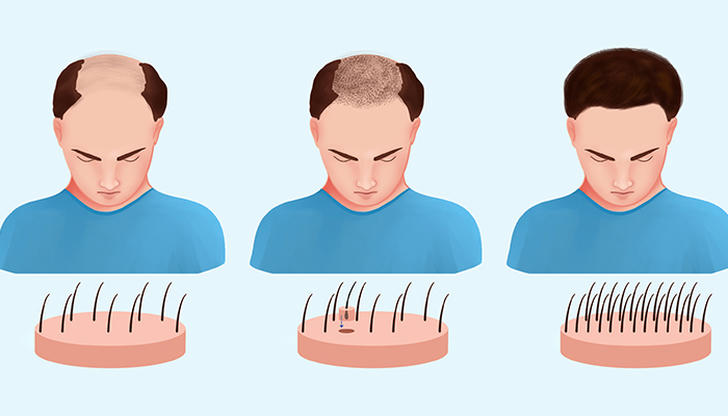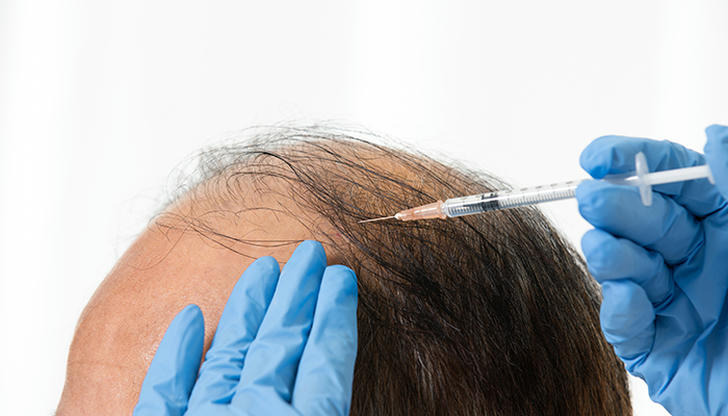Ten Facts About A Hair Transplant
Advertisement

Long, strong and shiny hair is almost everyone's dream yet not everyone is able to fulfill it. So many people will choose a hair transplant, which helps bring back what looks like a full -- or at least a fuller -- head of hair. However, everything comes at a cost, and not just in terms of money.
Having a hair transplant procedure is a big decision, so it's important not to rush into anything. You should take full consideration into this cosmetic procedure to avoid impacting on your emotional well-being.
What Is a Hair Transplant?

A hair transplant is a type of surgery procedure, which moves hair to an area that's thin or with no hair. A hair transplant is also a cosmetic surgery, so its cost cannot be covered in the medicine insurance plan. Due to most hair transplants being outpatient surgeries, it means you can go home or go to work the same day as the procedure.
How does a hair transplant work?

Firstly, the surgeon will clean your scalp and inject medicine to numb the back of your head - which is thought to be thickest hair on one’s head. Secondly, your doctor will take grafts, or small pieces of skin, from areas of the body that contain healthy hair. This area is also called the donor site. Thirdly, the doctor moves the grafts to hairless parts of the scalp.
Once the transplanted skin heals, it should continue to grow hair. In most cases, these transplanted hairs may fall and would regrow new hairs later. Sometimes, permanent hair loss can happen due to several reasons, including types of alopecia.
What are types of hair transplant surgery?

A hair transplant is a surgery, also called hair restoration or hair replacement. Usually, people have already tried many hair loss treatments but fail on these experiments. So they try to choose a hair transplant. Under local anaesthetic and sedation, you'll be awake but will not feel any pain. Commonly, there are 2 types of hair transplant.
Follicular unit strip surgery (FUSS)
With FUSS, a 6- to 10-inch strip of skin from the back of your head will be removed and then set it aside and sewed the scalp closed. This strip of skin will be divided into 500 to 2,000 tiny grafts. Each containing 1 to 4 hairs (hair grafts). Lastly the grafts are placed into tiny cuts made in the scalp.
Something during this procedure, you should be aware of •How many grafts can you get? It totally depends on your hair type, quality, color, and the size of your transplant area. •Will a scar be left on the back of your head? Yes, but it should not be visible unless you have very short hair. This area is immediately hidden by the hair around it. •Does your head need to be shaved? Nope, only the area where there the removed skin need to trim.
Follicular unit extraction (FUE) Before your doctor prepare the grafts, they will do the following procedures. •The surgeon will clean and numb the area where the hair will go. •Usually the back of the head needs to be shaved. •The surgeon creates holes or slits with a scalpel or needle, and individual hairs are removed 1 by 1 , then the grafts are placed into tiny cuts made in one of the holes delicately. After procedure, there will a lot of tiny scars, which are not very noticeable. If a large area is being treated, you may need to have 2 or more sessions.
All these two types of hair transplants usually take a day, but you should not need to stay overnight. Your doctor will tell you how to look after your graft. Sometimes, a spray is needed to be taken to help recovery and hair growth.
What are the benefits of hair restoration?

Say good bye to baldness. A hair transplant eliminates your hair-related issues and brings you much happiness. Meanwhile it will improve your self-esteem and appearance. The most important is that hair restoration may be unnoticeable to all, it looks very natural. And it may provide you a permanent hair loss solution.
Who can have a hair transplant?
If you want to have a hair transplant, you need to confirm whether it is suitable. Sometimes hair loss is temporary, such as bald patches, your hair will regrow later. Hair implants may be suitable for people with permanent baldness caused by: •Baldness, that runs in families. •Thyroid diseases or hormonal imbalances. •Traumatic injuries or burns. •Androgenic alopecia, or pattern baldness.
In addition, you need to be in good health and have realistic expectations about hair replacement results.
How much a hair transplant costs?

The price of a hair transplant will depend largely on the amount of hair you're moving, the type of procedure you choose, and the quality of the clinic and its team.
Usually it will cost you a pretty penny... So before surgery, you need to confirm the final amount of your hair transplant.
What to think about before you have a hair transplant?

If you're thinking about having a hair transplant, you need to check the Care Quality Commission (CQC). And you need to pay more attention to search the internet for clinics that do hair transplants. And check if the doctor is qualified.
Before deciding on any procedure, make sure you speak to a professional. Some questions you need to ask your doctor in detail: •What about their qualifications and experience. •How the procedure will affect you. •How many complications cases occur during other patients’ hair transplants and what are they. •What sort of follow-up you should expect if things go wrong.
What’s more, you need to ask yourself some questions:

•Why do I want to change and undertake a hair transplant? •What triggered me to think about a procedure now? •Am I expecting the procedure to change my life as well as my appearance? •Can I afford the costs of the procedure? •Can I afford any future costs to maintain the effect? •What am I expecting the procedure - to please someone else, improve my relationship, social skills or job prospects or others? •Can I tolerate any complications? •Have I made a detailed search about this surgery?
What to do if you have problems?

A hair transplant is a relatively safe surgery, but sometimes it may go wrong and the results may not be what you expected.
If you're not happy with the results, or your surgery are not carried out properly, speak with the surgeon who treated you, or you can file a complaint to some department.
You should contact the clinic or doctor where you had your hair transplant intermediately if you have severe pain or any unexpected symptoms. Especially, you experience any of the following problems: •Excessive bleeding from your scalp. •Severe redness or pain on your scalp. •Some infection in your scalp. •A fever happens for some time.



